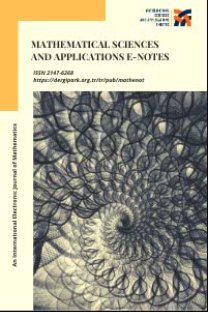On the Coherent Systems Subject to Marshall-Olkin Type Shocks
On the Coherent Systems Subject to Marshall-Olkin Type Shocks
___
- [1] Marshall, A. W., Olkin, I.: A multivariate exponential distribution. J. Amer. Stat. Assoc. 62, 30-44 (1967).
- [2] Ozkut, M., Bayramoglu,I.: On Marshall–Olkin type distribution with effect of shock magnitude. J. Comput. Appl. Math. 271, 150-162 (2014).
- [3] Bayramoglu, I., M. Ozkut: The reliability of coherent systems subjected to Marshall-Olkin type shocks. IEEE Trans. Rel. 64, 435-443 (2015).
- [4] Durante, F., Girard, S., Mazo, G.: Marshall–Olkin type copulas generated by a global shock. J. Comput. Appl. Math. 296 638-648 (2016).
- [5] Habib,A., Al-Seedy, R.O., Radwan,T.: Reliability evaluation of multi-state consecutive k-out-of-r-from-n: G system. Applied Mathematical Modelling 31, 2412-2423 (2007).
- [6] Ozkut, M., Eryilmaz, S.: Reliability analysis under Marshall–Olkin run shock model. J. Comput. Appl. Math. 349, 52-59 (2019).
- [7] Neuts, M.F., Meier, K.S.: On the use of phase-type distributions in reliability modeling of systems with two components. OR Spektrum 2, 227-234 (1981).
- [8] He, Q.M.: Fundamentals of matrix-analytic methods, New York. Springer, (2014).
- [9] Pérez-Ocón, R., Segovia, M.C.: Shock models under a markovian arrival process. Math Comput Model 50, 879-884 (2009).
- [10] Segovia, M.C., Labeau, P.E.: Reliability of a multi-state system subject to shocks using phase-type distributions. Appl Math Model 37 4883-4904 (2013).
- [11] Zhao, X., Guo, X., Wang, X.: Reliability and maintenance policies for a two-stage shock model with self-healing mechanism. Reliab Eng Syst Saf 172, 185-194 (2018).
- [12] Cui, L., Wu, B.: Extended phase-type models for multistate competing risk systems. Reliab Eng Syst Saf 181, 1-16 (2018).
- [13] Tank, F., Eryilmaz, S.: The distributions of sum, nima and maxima of generalized geometric random variables. Statist. Papers 56, 1191-1203 (2015).
- [14] Bayramoglu, I., Ozkut, M.: The reliability of coherent systems subjected to Marshall–Olkin type shocks. IEEE Trans. Reliab. 64(1) 434-443 (2015).
- [15] Bairamov, I., Parsi, S.: Order statistics from mixed exchangeable random variables. J. Computat. Appl.Math., 235 4629-4638 (2011).
- [16] F. J. Samaniego: On closure of the IFR class under formation of coherent systems. IEEE Trans. Rel., 34 (1) 1508-1527 (1985).
- [17] Kochar, S., Mukerjee, H., Samaniego, F. J.: The "signature" of a coherent system and its application to comparisons among systems. Naval Res. Logistics 46, 507-523 (1999).
- [18] Navarro, J., Rychlik, T.: Reliability and expectation bounds for coherent systems with exchangeable components. J. Multivariate Anal. 98, 102-113 (2007).
- [19] Eryilmaz, S.: The number of failed components in a coherent system with exchangeable components. IEEE Trans. Reliab. 61, 203-207 (2012).
- [20] Nama, M.K., Asadi, M.: Stochastic properties of components in a used coherent system. Methodol. Comput. Appl. Probab. 16, 675-691 (2014).
- [21] Navarro, J., Hernandez, P.J.: Mean residual life functions of finite mixtures, order statistics and coherent systems. Metrika 67, 277-298 (2008).
- [22] Ucer, B., Gurler, S.: On the mean residual lifetime at sys-tem level in two-component parallel systems for the FGM distribution. J Math Stat 41, 139-145 (2012).
- [23] Bayramoglu, I., Ozkut, M.: Mean residual life and inactivity time of a coherent system subjected to Marshall–Olkin type shocks. J. Comput. Appl. Math 298, 190-200 (2016).
- ISSN: 2147-6268
- Yayın Aralığı: 4
- Başlangıç: 2013
- Yayıncı: -
Simple, Double and Isoclinic Rotations with a Viable Algorithm
Melek ERDOĞDU, Mustafa ÖZDEMİR
Some Properties on Sums of Element Orders in Finite p-groups
About Trigonometric-polynomial Bounds of Sinc Function
Ramkrishna M. DHAIGUDE, Christophe CHESNEAU, Yogesh J. BAGUL
Certain Semisymmetry Curvature Conditions on Paracontact Metric (k, µ)-Manifolds
Some Remarks on MCI Crossed Modules
A New Paranormed Series Space and Matrix Transformations
Siacci’s Theorem for Frenet Curves in Minkowski 3-Space
Arzu CİHAN, Ayşe ZEYNEP AZAK, MEHMET ALİ GÜNGÖR
Ramkrishna M. DHAIGUDE, Christophe CHESNEAU, Yogesh J. BAGUL
